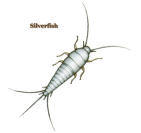Fabric Pests
The group of insects known as fabric pests includes silverfish, clothes moths and carpet beetles. Except for the silverfish, the main food constituent sought after by fabric pests is a protein substance called keratin, present in fibres of animal origin such as wool. Silverfish prefer to eat substances of plant origin such as cotton cellulose and starch.
Silverfish
Silverfish (Ctenolepisma longicaudata) are wingless, primitive insects and can be easily identified by the three long appendages protruding from the rear of the abdomen. They have a fish-like appearance with the body tapering to the rear and are covered in scales, giving them a dull silvery colouration.
The female adult lays eggs either singly or in small batches, which usually hatch after a period of 2-8 weeks into nymphs which closely resemble the shape of the adult but are smaller in size. The nymphs undergo a series of moults over a period of 3-24 months, becoming sexually mature adults. They are one of the few insects to continue moulting after they have achieved adulthood and can go on to live for a period of up to 4 years.
Silverfish can move extremely quickly when disturbed and in general have a tendency to avoid light. They are usually found in dark undisturbed areas, however they often range throughout a building particularly in cupboards, stored paper and bookshelves, and behind wallpaper that has peeled away from the wall surface. Silverfish cannot climb smooth surfaces and so are often found trapped in glasses, baths and basins. Silverfish do not carry disease organisms harmful to man or domestic animals.
Control of silverfish is normally achieved by the storage of books, paper and linen fabrics in well lit and ventilated areas. Chemical control consists of the careful application of residual surface sprays and the judicious use of space sprays.
Carpet Beetles
The most common carpet beetles to be found attacking various fabrics of animal origin are the black carpet beetle (Attagenus unicolor) and the variegated carpet beetle (Anthrenus verbasci).
As well as carpets, they can be found in woollen goods, fur, silk, upholstery and stuffed animals.
An infestation of carpet beetles usually occurs in undisturbed areas, such as below items of heavy furniture or perimeter areas of the carpet. It is possible for the carpet beetles to attack synthetic carpets, particularly if they are heavily soiled with organic food debris or urine. Many synthetic and woollen carpets are now treated with insecticides at the manufacturing stage rendering them resistant to carpet beetle attacks.
The adult female beetle lays her eggs in dark undisturbed areas. The eggs hatch into reddy-brown coloured larvae or grubs covered with tufted hairs. It is this larval stage that causes the damage to fabrics, rugs, underfelts and carpets. When they are fully fed the larvae change into an immobile pupal stage which, after several weeks, turn into adult beetles. The adult beetles usually fly to exterior areas where they are often attracted to white flowers. The adult beetles cause no further damage but often further infest dwellings by their presence in birds’ nests or being introduced to the interior of dwellings on cut flowers.
Control of carpet beetle is usually achieved by attention to thorough vacuuming of the infested areas followed by the application of residual insecticide sprays.
Clothes Moths
Although less common than carpet beetles, these fabric pests are commonly experienced in similar environments to carpet beetles, namely woollen materials, felt, fur and other materials of animal origin. The two most common species of clothes moths are the case making clothes moth (Tinea pellionella) and the common clothes moth (Tineola bisselliella).
The female clothes moths lay eggs on materials that will provide an adequate food source for the emerging larvae. The larvae or grubs feed in dark undisturbed areas and larvae can be protected by a “case” woven from the fibres of the material on which they are feeding, (case making clothes moth). When the larvae are fully fed the case making clothes moth larvae migrate to areas high up on the wall or on the ceiling to pupate, whereas the common clothes moth pupates within the feeding material.
The pupa of both species change into the adult moth and are usually short lived. Signs of clothes moth activity is indicated by the presence of damaged material, cast larval skins and sand-like larval droppings.
Control of clothes moth generally consists of the application of short residual low toxicity preparations to affected areas. It may be necessary to space spray affected areas to control adult clothes moths.
It is also possible for the householder to place small affected items into dark plastic bags and place these in a sunny position, thus raising the temperature to a lethal temperature for the pest. When storing clothes for long periods, these should be dry before being stored in clean plastic bags with moth balls.
